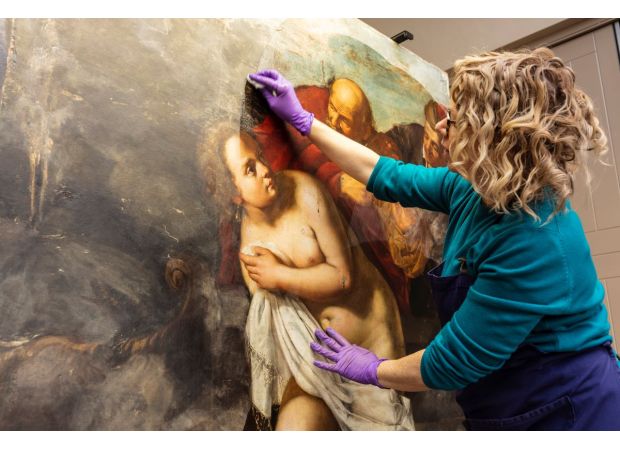A rarely seen work by Artemisia Gentileschi is being exhibited in Scotland for the first time.
Rare painting by female artist Artemisia Gentileschi on display in Scotland for the first time, after being rediscovered and restored.

A stunning painting by the renowned artist Artemisia Gentileschi, who was widely regarded as the greatest female artist of her time, has been unveiled at the Palace of Holyroodhouse in Edinburgh. After being lost for over two centuries and mistakenly attributed to another artist, the painting was recently rediscovered in the Royal Collection. Following extensive conservation efforts, it was first displayed at Windsor Castle in 2023.
The painting, titled Susanna and the Elders, offers new insight into Artemisia's creative process and her time in Great Britain during the late 1630s. During this period, she worked alongside her father Orazio Gentileschi at the court of King Charles I and Queen Henrietta Maria. Along with this rare masterpiece, visitors can also marvel at Artemisia's famous Self-Portrait as the Allegory of Painting, considered one of her greatest works. These two paintings now grace the ornate baroque interiors of the Palace of Holyroodhouse.
Upon close examination, it is evident that the left side of the painting has been obscured by layers of dirt, overpaint, and varnish accumulated over centuries. On the other hand, the right side has undergone extensive conservation work. "Artemisia Gentileschi is one of the finest artists of the Italian Baroque period, achieving great success during her own lifetime when few women artists were formally recognized," says Emma Stead, Curator at the Palace of Holyroodhouse. "Today, she is celebrated for her skillful technique and her ability to empathize with and empower the female subjects in her paintings, a rare quality in the male-dominated art world of her time."
Stead goes on to express her excitement at being able to display the painting in Scotland for the first time, shedding light on the journey of this masterpiece through the centuries. Its history can be traced back to its creation in the 1630s when it was displayed at Whitehall Palace. It then made its way to Hampton Court Palace, where it was stored for over a hundred years, attributed to the "French School" and in poor condition. However, thanks to the efforts of Royal Collection Trust curators, led by former staff member and art historian Dr. Niko Munz, the painting was identified and restored.
Artemisia Gentileschi, one of the most renowned artists of the 17th century, gained fame across Europe after receiving training from her father in Rome. She then went on to work for aristocratic and royal patrons in Florence, Naples, Venice, and London. Despite her success during her lifetime, her work fell out of favor in the 18th and 19th centuries. It is only in the last 50 years that she has been recognized for her powerful and empathetic depictions of women from history.
The recently rediscovered painting depicts the biblical story of Susanna, who is caught off guard by two men while bathing in her garden. When she refuses their advances, she is falsely accused of infidelity, a crime punishable by death. Artemisia's interpretation of the scene is unique as she focuses on Susanna's vulnerability and discomfort as she turns away from the lecherous men. This was a story that resonated with her, given her own experience of sexual assault at the age of 17. She was raped by an artist in her father's workshop and subjected to a grueling trial.
The painting's history is remarkable as it can be traced back through every century since its creation. It is believed to have been commissioned by Queen Henrietta Maria around 1638-39, during the redecoration of her apartments for the birth of a royal child. An inventory from 1639 lists the painting as hanging above a fireplace in the Queen's Withdrawing Chamber at Whitehall Palace, a private room used for small gatherings. After the restoration of King Charles II in 1660, the painting was returned and hung above a fireplace at Somerset House, the residence of queens and consorts.
In the 18th century, as Artemisia's reputation declined, the painting lost its attribution and was moved to Kensington Palace, where it was considered the work of a minor or unknown artist. It was later transferred to Hampton Court Palace, where it lost its frame and underwent conservation in 1862. However, following its rediscovery, the painting was extensively restored by Royal Collection Trust conservators. Layers of dirt, discolored varnish, and non-original paint were carefully removed to reveal the original composition.
Visitors can now admire this rare masterpiece by Artemisia Gentileschi at the Palace of Holyroodhouse, a testament to her incredible talent and perseverance. To learn more about the rich culture and history of Scotland, be sure to subscribe and read the latest issue of Scottish Field.






